
1
Overall view of the carbine with some of the common issue accessories including oiler, cleaning kit, ammo packages, cartridge boxes, 1895 Nagant revolver and holster.
| 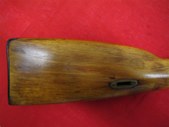
2
View of buttstock. Note that stock is made from a rebuilt M91 stock. The Tsarist roundel is still barely visible.
| 
3
Viw of action area, bolt handle side.
| 
4
View of rear sight area. Note that the rebuilt M91 stock is inlet for an M44 type folding bayonet. Also note the stock is retrofitted for sling slot escutcheons.
|
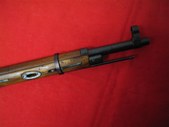
5
View of muzzle area.
| 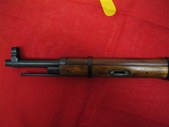
6
Another view of the muzzle area.
| 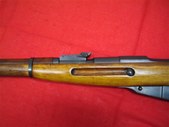
7
View of rear sight area. Note the well machined finger grooves, probably re-machined when the stock was converted from an M91 stock.
| 
8
View of action area, bolt opened. Note that most parts are re-used M91 parts.
|
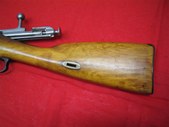
9
Buttstock view. Note old serial number on buttstock from its days of being an M91 stock on another rifle.
| 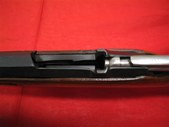
10
View of open action.
| 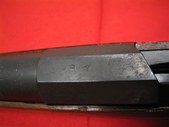
11
Note the receiver stampings. It is commonly thought that these markings are of Czech arsenal origin.
| 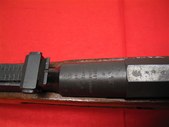
12
Note the barrel markings showing that this rifle started life as either an M91 infantry rifle or an M91 Dragoon made at Tula in 1909.
|
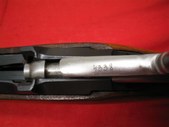
13
Note that the bolt has been very cleanly scrubbed and polished, more so than on typical Soviet refurbished Mosins. The serial number has been neatly electropencilled on. Appoximately half of M91/38 carbines seem to have electropencilled bolts, the remaining seem to be stamepd to match at the time of rebuild.
| 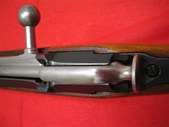
14
Cocking piece.
| 
15
Note the rather nice polishing job on the bolt parts.
| 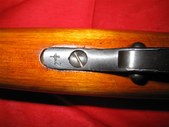
16
Note that the magazine hosing is pre-1928 Izhevsk. Most parts save the sights and band assemblies are recycled from M91 rifles and dragoons.
|
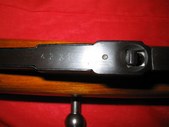
17
Note the floorplate is weakly stamped matching. All serial numbers are done in different fonts on this carbine indicating that either the parts were renumbered in different arsenal workshops or the carbine was subject to more than one rebuild before ending up in its current state.
| 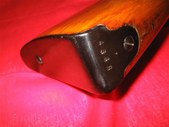
18
Serial numbers on the buttplate which seems to be polished and reblued at refurbishment.
| 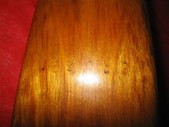
19
The old serial number stamepd into the re-used stock.
| 
20
The remnants of the Imperial M91 roundel in the buttstock.
|
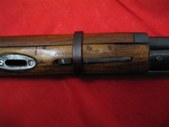
21
Note the rather well done glued and dowelled stock repair, not the typical undowelled and crudely glued Soviet repair.
| 
22
Here we can see that hte front sight assembly is an M44 type sleeve with the bayonet lug machined off, not a typical M38 sight collar. The M44 sight retaining pin can be made out as a contrasting purple line to the rear of the sleeve. All known M91/38 carbines hve these machined M44 sight assemblies.
| 
23
Note that the M44 sight sleeve is of the post-war wide-base type indicating manufacture in 1946 or later. this is fairly conclusive proof that the M91/38's were converted post-war.
| 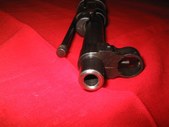
24
Another view of the post-war wide-base front sight.
|
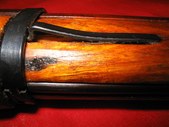
25
Note that wartime/post-war stamped bands and springs were used on these carbines in contrast to all the re-used milled M91 parts.
| 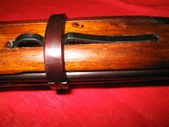
26
Note here the stamped front band spring and the purplish hue of the front band indicating a high nickel content often seen on easter-european rifle parts, but uncommon on Soviet made bands. Neither band is maker-marked like Soviet bands typically are.
| 
27
Floorplate and follower assembly recycled from M91 production. Note the pre-1928 design of the parts.
| 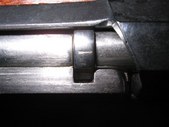
28
Note that the connector bar was made by Sestroryetsk indicating WW1 or earlier manufacture.
|
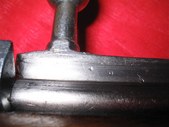
29
The bolt body os also Sestroryetsk. It's probably that the bolt is originally a complete Sestroryetsk bolt renumbered and refurbished for this carbine.
| 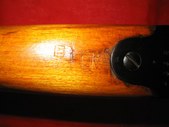
30
Here we see some more recent stock stamps, a rectangle with a 17 inside it, stamped twice. It is thought this is also a stamp of Czech origin.
| 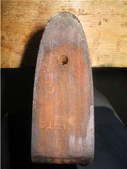
31
Here we see the markings under the buttplate which prove that this stock was originally made in 1914 for use on an Imperial M91 or Dragoon before it was cut down into a carbine stock.
| 
32
Here we see that there is a pin through the trigger slot which prevents removal of the sear. It is thoght that this modification may have been done to ensure this trigger and sear remained together when the carbine was disassembled for maintenance. Possibly they were "tuned" to this carbine, thogh that is just conjecture. It is not a common trait on Mosins and too few M91/38's have been observed to ascertain if it is common practice on these carbines.
|

33
Note hte cyrrilic stamp on the inside of the handguard. Though this likely points to Slavic involvement in the conversion of these pieces, it has often been suggested that the conversions, if done in Czechoslovakia, were on contract for another country.
| 
34
Overall view of the barel and receiver markings.
| |

